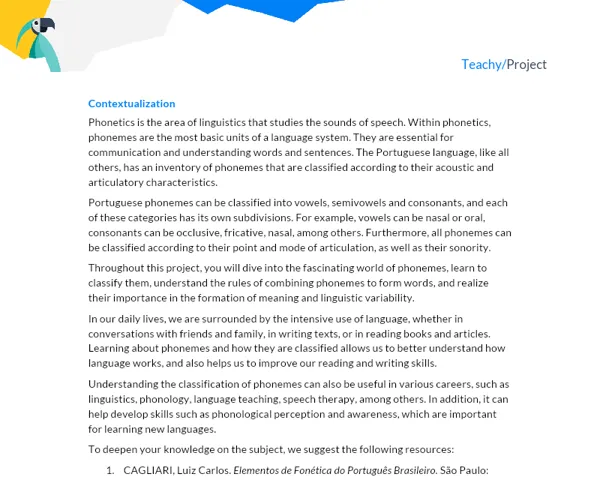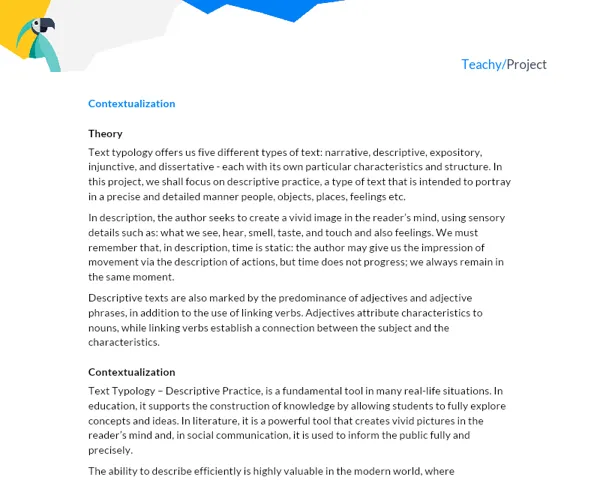Contextualization
With the explosion of information produced and shared daily, it has become increasingly common to come across references to other texts in a single text. These references, whether explicit or implicit, are what we call intertextual relations. Understanding this concept and being able to identify it is essential for the interpretation of many contents we consume, whether in a book, a news article, or even a film or series.
The study of intertextual relations is an essential part of the Portuguese language discipline, as it allows students to develop a deeper understanding of how different texts can engage with each other, enriching the interpretation and understanding of texts and discourses. Intertextuality is a resource widely used in literature, cinema, advertising and journalism, among other areas.
By learning to identify and analyze these relationships, it will be possible to better understand not only the main message of a work, but also to perceive the different layers of meaning that may be present through the reference to other texts. In addition, by studying intertextuality, we can develop a more critical view of the texts and discourses we consume daily.
Introduction
For our project, it will be essential to understand that intertextuality is configured as a co-presence relationship between two or more texts. This means that a text (receiving text) presents parts of other texts (donor text), forming a network of references and citations. This relationship can occur in different ways and for different reasons, the most common being parody, paraphrase, pastiche and citation.
By identifying the intertextual references, it is possible to have a deeper understanding of what the author of the receiving text wants to communicate. Often, the reference to another text serves to reinforce an idea, make a criticism, make humor, among many other possibilities. Therefore, throughout this project, you will be encouraged to investigate and analyze examples of intertextuality in different textual formats.
Here are some reliable resources to help you delve into the topic:
- Intertextuality - Prof. Noslen
- Text and Intertext - Alfa: Journal of Linguistics
- Intertextuality and Parody - Carlos Alberto Faraco
And remember, intertextuality is not a seven-headed beast! With a little attention and practice, it will become easier and easier to identify and understand it.
Practical Activity
Activity Title: "Intertextuality in Action"
Project Objective:
The objective of this project is to provide students with the experience and development of skills related to the study and application of the concept of intertextuality.
Students will work in groups of 3 to 5 people to identify and analyze examples of intertextuality in different media, such as literature, cinema, music and social media, and later create their own intertextual texts.
Detailed Project Description:
O projeto "Intertextuality in Action" is divided into three phases:
In the first phase, "Identifying Intertextuality", students should look for examples of intertextuality in different media of their choice. The examples should be documented with details about their origin, the context in which they appear and which text(s) they refer to.
In the second phase, "Analyzing Intertextuality", students will analyze the examples found. They should discuss and document the following questions: What is the effect of intertextuality on the text? What additional meaning does it bring? How does it affect the interpretation of the text as a whole?
In the final phase, "Creating Intertextuality", students will use what they have learned to create their own intertextual texts. They should strive to create texts that make references to other works in a creative and meaningful way.
Materials needed:
- Internet access for research and documentation
- Books, movies, music and social media to find examples of intertextuality
- Paper and pen or computer with text editor for writing the final report
Step by Step Detailed Guide to Carry out the Activity:
- Form groups of 3 to 5 students.
- Each group should choose different media to find examples of intertextuality (literature, cinema, music, social media, etc.).
- After choosing the media, the groups should research and document at least 5 examples of intertextuality from each chosen media, indicating the text in which the intertextuality occurs, the text it refers to and the context in which it occurs.
- With the examples in hand, the groups should discuss and analyze the effect of intertextuality on the texts and document their analysis.
- After analyzing the examples, the groups should dedicate themselves to creating their own intertextual texts. It can be a single text per group or each member of the group can create their own text.
- Finally, each group should write a report detailing the entire work process, according to the guidelines given below.
Project Deliverables and Guidelines for the Final Report:
The final result of the project will be a written report and the intertextual texts created by the students. The report should follow the following structure:
- Introduction: Contextualization of the theme of intertextuality, statement of the project objective and brief comments on the importance of understanding intertextual relations.
- Development: This part should be divided into three subsections:
- Identification of Intertextuality: Here, students should list the examples of intertextuality found in different media, with the respective contextualization.
- Analysis of Intertextuality: In this subsection, students should present their analysis on the effect and meaning of intertextual relations in the texts analyzed.
- Creation of Intertextuality: Here, students should present the intertextual texts they have created, explaining the intertextual relations in them and justifying their choices.
- Conclusion: Recap of the main points of the work, statement of the learnings obtained and the conclusions drawn about the project.
- Bibliography: Indication of the sources used for the research and preparation of the project.
The intertextual texts created by the students should be presented annexes to the final report.



